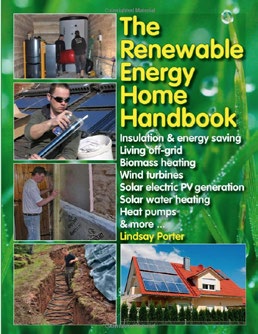From Living Woods issue 53
‘Think global, act local’ – ANGUS HANTON is inspired by the energy saving tips and advice in converting your home to renewable energy
 THE RENEWABLE ENERGY HOME HANDBOOK
THE RENEWABLE ENERGY HOME HANDBOOK
Lindsay Porter
Veloce Publishing
Hardback 192 pages £24.99
ISBN 978-1845847593
You may think that YouTube is totally taking over from
more traditional guidebooks, but this handbook shows
there is still an important place for the printed guide.
It’s much easier to take up onto the roof, read in the loo, and
for writing notes in the margins. Homeowners often wonder
how to use less power and yet stay warmer, but it’s hard
to know where to start. The Renewable Energy Handbook
doesn’t begin with renewable energy at all – it starts with
saving energy, insulating the house and monitoring. I love this
approach because this is where the low-hanging fruit is –
changing those 50 watt light bulbs for 7 watt LED bulbs that
give out exactly the same amount of light and a lot less heat.
I also like this way of thinking because it’s not just about
heating, but about cooling too – when you insulate your
house you stay cooler in the hot summers as well as warmer
in winter. Whilst these are helpful generalisations, what’s
also needed is actual measurement and there are now very
cheap ways to measure your electricity consumption – the
handbook recommends the Eco-Eye devices that tell you in
real time how much ‘juice’ you are using.
This handbook is the epitome of ‘think global, act local’, as it
starts with an explanation on why cutting our CO2 emissions
is essential for the planet, and ends up, 170 pages later, with
how to use a Makita 18v cordless drill to install a radiator.
Throughout, Lindsay is the practical geek, holding your
hand as you insulate pipes and work out which way your
solar panels should face. And his expertise in making homes
greener goes back a long way – in the 1970s he discovered
from Swedish builders that making an eco-house costs very
little more than constructing a ‘gas-guzzling’ building.
Most home owners will stay connected to the grid but
take less electricity from it, but the handbook does take
you through the practicalities getting off-grid with the
use of battery back-up. Many people will want to put in
solar thermal for heating the hot water (what children call
‘sunshine water’) and Lindsay wants you to understand every
stage. The process is fully illustrated and explained – some
pages have 10-12 pictures. There must be well over 1,500
photos and illustrations in the handbook.
Projects you could undertake with the handbook include
putting in insulation, a solar thermal system, solar panels for
creating electricity, a ground source heat pump, an air source
heat pump or a wind turbine. More whacky, but logical, ideas
include an exercise bike generator – why not use cycling
energy to light your home? Another often-overlooked idea
is putting in a heat recovery system to take out heat from
waste-water and air leaving your home.
If you’re putting in solar panels yourself or putting up a
domestic wind turbine then the £25 investment in this book
has to be a bargain. Reading it might lead you to the same
experience the author had: ‘until I started on this book, I
thought I knew quite a lot about renewable energy . . . but I
discovered how much I didn’t know.’